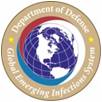
Overview. Based in Nairobi, Kenya, the USAMRU-K DEID coordinates the regional DoD GEIS program activities including infectious disease surveillance, outbreak response, infrastructure development, and capacity building through education and training initiatives in East and Central Africa. Initiated in 2001, USAMRU-K’s DoD GEIS Program is the most mature program in the region. Surveillance is performed using an extensive multi-site collection network involving clinicians and laboratory technicians trained on case recruitment and proper specimen handling/testing. Surveillance sites are located primarily in district hospitals throughout several regions and cover a broad range of cultures and environments in Kenya, Uganda, Tanzania and Cameroon. We focus on 5 disease pillars, Respiratory pathogens, Enteric Pathogens, Acute Febrile Disease pathogens, Sexually Transmitted pathogens and Antimicrobial resistance in general. Outbreak response is conducted on a regional basis at the request of Ministries of Health or the World Health Organization (WHO) and is generally conducted as a collaborative multi-U.S. agency effort with the Centers for Disease Control (CDC) in Kenya. Training initiatives and local capacity development include three-month laboratory internships in emerging infections and laboratory analysis and support of host nation scientists graduate education. Using this model, the USAMRU-K DEID and DoD GEIS programs have expanded to Uganda, Tanzania, and Cameroon initially focusing on influenza surveillance and response. In Uganda activities have expanded to include Antimicrobial resistance. In Tanzania, activities have expanded to include Acute Febrile Illness (AFI) and in Cameroon we have expanded in to Sexually Transmitted Infections other than HIV.
Kenya Program. Operated under a cooperative agreement with the Kenya Medical Research Institute (KEMRI).
• 13 active protocols include human influenza, arbovirus, enterics, malaria drug resistance surveillance.
• Kenya staff includes 6 Primary Investigators, 26 laboratory technicians, 7 administrative staff, and 28 field personnel.
• Public health response efforts include Rift Valley Fever virus, 2006/07, Pandemic Influenza in 2009 and Dengue 3/2 out break in the North East region of Kenya in 2011.
• 11 field surveillance sites throughout Kenya.
• 4 Kenyan laboratories to include the Microbiology Hub (Kericho); Kenya National Influenza Center (NIC) with KEMRI serving as a WHO regional reference laboratory, WHO Regional Reference Laboratory for Arboviruses and Viral Hemorrhagic Fevers; and the Malaria Drug Resistance Laboratory (Kisumu).
Uganda Program. Implemented by the Makerere University/Walter Reed Project (MUWRP).
• 3 GEIS activities involving human sentinel and migratory/domestic bird influenza surveillance and Antimicrobial Resistance Surveillance.
• Uganda staff includes 3 Primary Investigators, 5 laboratory technicians, 1 Lab Manager/Virologist, 1 administrative staff, 1 Clinical Officer and 8 field personnel.
• 2 Uganda laboratories to include Uganda NIC in collaboration with the Uganda Virus Research Institute (UVRI) and the Virology Laboratory, Makerere University, College of Veterinary Medicine , Animal Resources and Biosecurity (COVAB).
Department of Emerging Infectious Disease